Archive for December, 2010
December 31, 2010
 Although not unprecedented, I am leading off with a photo that is not a car although, as I will explain is car related….kind of.
Although not unprecedented, I am leading off with a photo that is not a car although, as I will explain is car related….kind of.
Photo credits to HRC/WENN via Wonder Wall for the picture. It is John Mellencamp with his wife Elaine. After 20 years they have decided to split and while it is sad, I hope the split works out for the better. Having went through a divorce myself, I can testify that it doesn’t have to be a mess and sometimes things have just run their course and it becomes time to move on.
Anyway, on to the long story. Having been born and raised in Indiana, John Cougar as he was known in the early days was a musical hero for me and I have followed his career in music since the start. He is the “Elvis Presley” of Indiana. He went through the New York and California stages and decided to come back to Indiana because he liked the “small town” life for raising a family and it just suited him better. That combined with the fact that you would never know by appearances that he was the multimillion dollar powerhouse that he is, is what led me to try my hand at becoming a “stalker”.
The Rolling Stone magazine ran an article about him and his life in Indiana back in August 2008. After reading the article I decided to try to approach him about my “Muscle Car” idea. So after a few hours of internet searches and map searches, I decided to drive to Bloomington, Indiana to talk with him. Now, I live north of Chicago, Illinois so while on the map it is mere inches apart, it is actually about a 6 hour drive one way. The PT Cruiser was gassed up and the mission was commenced on Labor Day weekend…Sunday. The drive is nice and while I can skip details of that, the end result was that after bothering his neighbor since I had picked the wrong driveway to buzz the gate, I finally located the correct address. It was a waste of time. No answer, and I remembered that a few years prior when I was vacationing at Hilton Head John and his family had also been there at the Holiday Inn at the same time, so quite possibly they were out-of-town for the weekend. My bad. With the 6 hours invested in the trip, I did have a backup plan, just in case.
That was to see if his friend and band mate Mike Wanchic would talk to me and possibly pass on some information I had printed up for John. I did find Mike’s house on the first try and he was home. We had a conversation in his driveway and afterwards I felt pretty good about what I wanted to do and that I had possibly made a connection that was going to get this deal rolling.
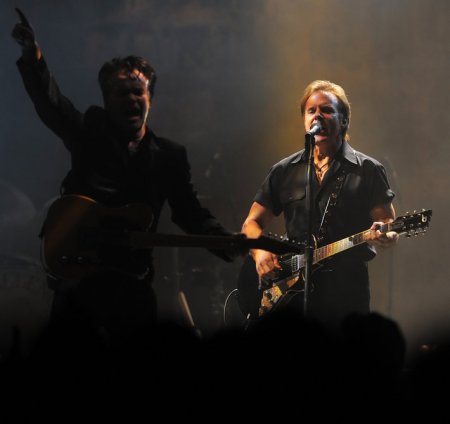 The photo credits belong to Matt Detrich/The Star and this is Mike Wanchic playing with John Mellencamp at the Hinkle Fieldhouse at Butler University on November 11, 2010. When I met Mike he had much shorter hair.
The photo credits belong to Matt Detrich/The Star and this is Mike Wanchic playing with John Mellencamp at the Hinkle Fieldhouse at Butler University on November 11, 2010. When I met Mike he had much shorter hair.
Anyway, the point is that while I do not know if Mike passed on the information or not because neither John or anybody else has ever gotten in touch with me, I am still plugging away at the Muscle car game one car at a time and still trying to get the ball rolling. I talk with a lot of people over the course of a year, and I do try not to be a pest but I am sure I am one anyway.
The whole point of this post is that while my dream may be silly to most and most of the time it seems as if it is a huge failure, you have to do what you believe in. With the New Year comes our New Years Resolutions and while most of us will not keep them or will fall flat on our faces, it is what helps drive us and makes us who we are. So while I keep plugging away at searching for my illusive “investor”, you should all be moving ahead towards your dreams as well. We have another year beginning and while we are not getting any younger, you cannot let your dreams die. Push on and keep trying, because sometimes dreams can and do come true.
Davey Boy
Tags:1957, 1965, 1967, 1968, 1969, 1970, 1971, 1973, 1975, 440, 442, 454, AMC, AMX, Automobiles, Bloomington, cars, Chevrolet, Chicago, Cutlass, detailing, drag racing, high return, Indiana, investments, John Mellencamp, Mike Wanchic, money, New Years, NHRA, Nova, Olds, Oldsmobile, Pontiac, Resolution, Trans Am, vehicle
Posted in Auctions, Automobiles, cars, current events, Muscle Cars, Racing, Stalker, Uncategorized | Leave a Comment »
December 24, 2010
 Just a short posting this time. It is Christmas Eve, so I have a lot of stuff to accomplish before the day is over. This time I have decided to give those who care my current “Christmas List” of vehicles. Just in case anyone out there cannot decide what to get me.
Just a short posting this time. It is Christmas Eve, so I have a lot of stuff to accomplish before the day is over. This time I have decided to give those who care my current “Christmas List” of vehicles. Just in case anyone out there cannot decide what to get me.
First we have the 1971 Plymouth GTX. Make sure it has the 440 and preferably the 6-Pack carb setup on it, but in a pinch, and since this is short notice the 4 barrel setup is also acceptable. The 1971 GTX was a new body style that had some added style to it compared to the 1970 with its slab sides and box styling. It should be a bucket seat interior with a 4 speed transmission as well. Don’t bother with the A/C option because when the temperature is 90 degrees or over, it won’t be driven since these Mopars are notorious for running hot in hard-driving.
What’s the point in having to sit in a parking lot waiting for the engine to cool down ? The version here also has an Air Grabber intake hood and air cleaner which makes it cost a few thousand more. But I never claimed to be a cheap date.
 These are not in any prefered order so any will be a fine choice for me. Next we come to a 1969 Pontiac Firebird 400 Convertible. It has to be a convertible because this one will be driven in hot weather also, unlike the GTX. Automatic transmission is also okay for this little screamer. The Camaro SS/RS with a 396 can be substituted, and those are more plentiful but will cost almost double or even triple what a Firebird will. Just trying to save you some cash people.
These are not in any prefered order so any will be a fine choice for me. Next we come to a 1969 Pontiac Firebird 400 Convertible. It has to be a convertible because this one will be driven in hot weather also, unlike the GTX. Automatic transmission is also okay for this little screamer. The Camaro SS/RS with a 396 can be substituted, and those are more plentiful but will cost almost double or even triple what a Firebird will. Just trying to save you some cash people.
 Then there is the 1970 Mercury Cyclone with the 429 Cobra Jet engine. There are several upgrades that can be added to the Cyclone. It could be a “GT” model or the “Spoiler” model and any will be fine with me. The Cyclone was based on the Montego model which was based on the Ford Torino, but the Torino never had the cache that a Cyclone did with the Muscle Car Crowd.
Then there is the 1970 Mercury Cyclone with the 429 Cobra Jet engine. There are several upgrades that can be added to the Cyclone. It could be a “GT” model or the “Spoiler” model and any will be fine with me. The Cyclone was based on the Montego model which was based on the Ford Torino, but the Torino never had the cache that a Cyclone did with the Muscle Car Crowd.
This is a vehicle that looks good in almost any color, whether it be Baby Blue, Yellow, White, Black, Blue, Red….it really does not matter.
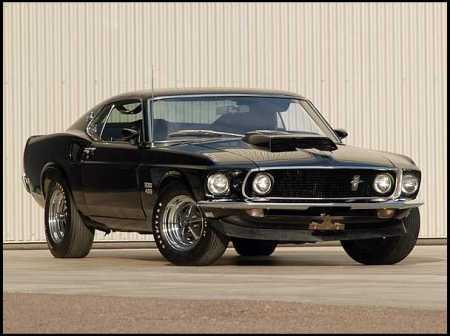 For any “High-Rollers” that are out there the next choice will be up to you guys to buy. That would be the 1969 Ford Mustang Boss 429. This car will set someone back $150,000 or more.
For any “High-Rollers” that are out there the next choice will be up to you guys to buy. That would be the 1969 Ford Mustang Boss 429. This car will set someone back $150,000 or more.
I refer back to the “I am not a cheap date” quote from earlier. This is the closest car to a factory built NASCAR vehicle you can find, even though the Mustang was not used in NASCAR.
Several tricks were used to actually make the heavy engined vehicle better balanced such as wider front suspension geometry and relocating the battery to the trunk and much beefier suspension up front. This would be an under 90 degree driver as well as the GTX. But that is what I will have to deal with and it is a challenge that I will gladly accept.
 The Boss 429 was made in 1969 and 1970 so either will be fine. For those who want to get me the 69 or 70 Mustang but cannot quite afford the price of a “Boss”, I will accept a Mach I with the 428 as well.
The Boss 429 was made in 1969 and 1970 so either will be fine. For those who want to get me the 69 or 70 Mustang but cannot quite afford the price of a “Boss”, I will accept a Mach I with the 428 as well.
Here we have the 1970 version with the 428 Cobra Jet engine. While only 1 cubic inch smaller in displacement it is about 100 horsepower less as well, due to the special pieces in the 429 Boss engine. That is alright with me because it is the thought that counts when someone buys me a gift. I can still wreak havoc on the city streets with the Mach I.
 The final choice for this list will be a 1971 Oldsmobile 442.
The final choice for this list will be a 1971 Oldsmobile 442.
Preferably a convertible. Automatic transmission is fine with me and although this is a 1971, I will take any year from 1969 through 1971. The version here is the W30 model. The engine is a special motor built by Oldsmobile with special heads, carb and exhaust as well as major mods to engine internals. This engine along with the Buick 455 used in its GSX have the distinction of having the highest torque of any engines built during the Muscle Car years. 500 foot pounds of torque was the claimed number and nobody else cracked the 500 mark back then.
So anyway…..that is my list. Everybody have a safe and joyous Christmas and enjoy some time with your families. God Bless all of you and thanks for following my blog.
Davey Boy
Tags:1967, 1968, 1969, 1970, 1971, 440, 442, 454, AMC, AMX, Automobiles, cars, Chevrolet, Chicago, Cutlass, high return, investments, making money, money, Muscle Cars, NHRA, Nova, Olds, Oldsmobile, Pontiac, profits, SS396, Trans Am
Posted in Auctions, Automobiles, cars, current events, Muscle Cars, NFL, Racing, Uncategorized | 1 Comment »
December 18, 2010
 When General Motors banned Factory based racing starting with January 1964, they set into motion what would become the most exciting era for performance enthusiasts. It would become the “Muscle Car Era”.
When General Motors banned Factory based racing starting with January 1964, they set into motion what would become the most exciting era for performance enthusiasts. It would become the “Muscle Car Era”.
With the mission of making a more unified midlevel model line for GM vehicles the decision was made to make each divisions midsize models more uniform in size and equipment. This was basically a cost saving move and viewed as a way for buyers to be able to compare models as being more equal to their competitors.
The up and coming younger executives at the Pontiac Division saw this as a way to draw more heavily on the “Youth” market by showing that they were more tuned to the performance end of the scale. John DeLorean with the help of fellow engineers Bill Collins and Russ Gee basically took the 398 engine that was in the full size Catalina and Bonneville and dropped it into the newly enlarged Tempest LeMans to create the Tempest LeMans GTO. There were other changes as well made to the vehicle to beef up suspension pieces and such, but the basic premise was to put the biggest engine possible into a lighter car and then sell it to the general public.
 There were several rules in place to prevent overzealous executives from having the factory build and sell cars that were too powerful and thus unsafe. Just like the “limited” production factory race cars made before them using loopholes in the rules, the GTO also used a loophole in the rules. This one involved labeling the vehicle as an option package not a regular model. In fact the GTO was an option of an option being first a Tempest with the upgraded LeMans package then adding the GTO package to that. Options included either a 4 barrel carburetor and the top engine was a tri-power setup with 3 two barrel carburetors. Frank Bridge was Sales Manager at the time and estimated the model would not be a big seller so he tried to limit production to 5000 units. The GTO actually sold 10,000 before the start of the 1964 calendar year and ended its first year run at 32,450 units.
There were several rules in place to prevent overzealous executives from having the factory build and sell cars that were too powerful and thus unsafe. Just like the “limited” production factory race cars made before them using loopholes in the rules, the GTO also used a loophole in the rules. This one involved labeling the vehicle as an option package not a regular model. In fact the GTO was an option of an option being first a Tempest with the upgraded LeMans package then adding the GTO package to that. Options included either a 4 barrel carburetor and the top engine was a tri-power setup with 3 two barrel carburetors. Frank Bridge was Sales Manager at the time and estimated the model would not be a big seller so he tried to limit production to 5000 units. The GTO actually sold 10,000 before the start of the 1964 calendar year and ended its first year run at 32,450 units.
The success of the GTO had the other GM Divisions rushing to come up with their own models for the segment. Chevrolet took the 327 from the Corvette and dropped it into the Chevelle Malibu and called it the Super Sport or SS as commonly called. While it did not carry the horsepower rating from the Corvette, only minor changes were made to the engine to detune it for the Chevelle.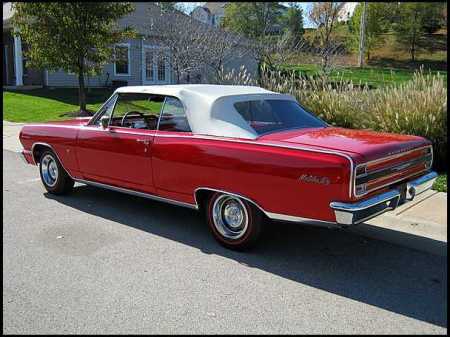
The pictures shown here show the Pontiac GTO 389 with a 4 barrel carburetor setup, then the GTO interior with its bucket seat interior and now the Chevelle Malibu 327 Super Sport.
As with the GTO the “option” loophole was used to put the SS model into production, since Chevrolet wanted no midsize model being competitive with the Corvette.
 The Oldsmobile division also came up with a version of a Muscle Car. They took the F-85 Cutlass and created the 442 option for it. This involved putting their Rocket 330 into it from the larger “88” model. Again it was an option for an option of an existing model. Loophole exploited. The Buick Division was the holdout for the 1964 year. They offered a 300 CID engine in the Skylark but did not create a special package vehicle for the model year.
The Oldsmobile division also came up with a version of a Muscle Car. They took the F-85 Cutlass and created the 442 option for it. This involved putting their Rocket 330 into it from the larger “88” model. Again it was an option for an option of an existing model. Loophole exploited. The Buick Division was the holdout for the 1964 year. They offered a 300 CID engine in the Skylark but did not create a special package vehicle for the model year.
 Ford was also looking at the sales success of the GTO and got into the Muscle Car game. They had the Ford Fairlane with a 289 HO and then since General Motors had pulled out of the Factory Race Game they had only Chrysler as direct competitors in Drag Racing. They fired the shot heard “round the world” with the Fairlane Thunderbolt.
Ford was also looking at the sales success of the GTO and got into the Muscle Car game. They had the Ford Fairlane with a 289 HO and then since General Motors had pulled out of the Factory Race Game they had only Chrysler as direct competitors in Drag Racing. They fired the shot heard “round the world” with the Fairlane Thunderbolt.
 This was a factory Drag Race car with its newly developed 427 cubic inch big block and fiberglass front end, doors and totally stripped of unneeded weight like sound insulation and seam filler and such. The inboard headlights were removed as that was the intake hoses to feed fresh air into the engine. Record keeping was not a strong suit and exact count for how many were made is in debate as to whether it was 111 or 127 but there were also 50 Mercury Cyclones produced by that division as well and some were modified to look like the Thunderbolt by either the factory or dealers. Even the windshield was a custom lightweight piece to save weight and so were the window roll down mechanisms as they were eliminated altogether.
This was a factory Drag Race car with its newly developed 427 cubic inch big block and fiberglass front end, doors and totally stripped of unneeded weight like sound insulation and seam filler and such. The inboard headlights were removed as that was the intake hoses to feed fresh air into the engine. Record keeping was not a strong suit and exact count for how many were made is in debate as to whether it was 111 or 127 but there were also 50 Mercury Cyclones produced by that division as well and some were modified to look like the Thunderbolt by either the factory or dealers. Even the windshield was a custom lightweight piece to save weight and so were the window roll down mechanisms as they were eliminated altogether.
 As you can see the Thunderbolt left very little room under the hood for anything but the massive engine and those huge air intake hoses to the dual carburetors.
As you can see the Thunderbolt left very little room under the hood for anything but the massive engine and those huge air intake hoses to the dual carburetors.
As the Fairlane with its 289 did not translate into the Street Wars that were starting to take shape, Ford was counting on its new Mustang model to appeal to the market. While it was technically a 1965 model the early models are considered 1964 1/2 since they had the 260 engine and generators instead of the 289 engine and alternator used for vehicles made when the true 1965 model production began. While the Mustang is credited with the creation of the Pony Car segment; hence the name Pony Car; it was actually beat to market by its competitor over at Plymouth by 2 weeks.
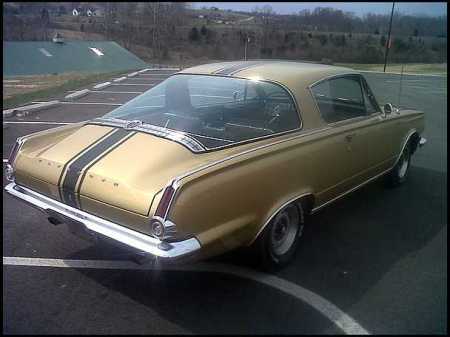 The Plymouth Barracuda was introduced on April 1, 1964 while the Mustang came out on April 17. Somehow I do not think the nickname of “Fish Coupes” would have endured as well as the term “Pony Cars”. The Barracuda had the 273 CID engine and at the time had the largest rear window ever made, when measured as square inches of glass area.
The Plymouth Barracuda was introduced on April 1, 1964 while the Mustang came out on April 17. Somehow I do not think the nickname of “Fish Coupes” would have endured as well as the term “Pony Cars”. The Barracuda had the 273 CID engine and at the time had the largest rear window ever made, when measured as square inches of glass area.
Well, this ties up the “Factory” models for 1964….although there were so many behind the scenes prototypes being tried and developed, I have probably left someone out of the mix here. If anyone knows about any let me know. Maybe I can amend this in future blogs.
Later all,
Davey Boy
Tags:1964, 1964 1/2, 1965, 1966, 1968, 1969, 1970, 1971, 427, 440, 442, 454, AMC, Automobiles, cars, Chevrolet, Chicago, Cutlass, drag racing, Fairlane, Ford, high return, Impala, investments, making money, Muscle Cars, Mustang, NHRA, Nova, Olds, Oldsmobile, Pontiac, profits, Racing, SS396, Thunderbolt, vehicle
Posted in Auctions, Automobiles, cars, current events, Muscle Cars, Racing, Uncategorized | 7 Comments »
December 12, 2010
 First off, let me say that I am not a “Historian”. I do not have the inside track on events or conversations within General Motors or Ford Motor Company. All I can relay to you is the events and stories about what happened to cause the time known as “The Muscle Car Era”.
First off, let me say that I am not a “Historian”. I do not have the inside track on events or conversations within General Motors or Ford Motor Company. All I can relay to you is the events and stories about what happened to cause the time known as “The Muscle Car Era”.
In the late 1950’s the “Hot Rodder” groups were established with the preferred equipment being the “flat head Ford” engine. Overhead cam V-8’s were the newest upgrade for horsepower, but were still being developed for what true power-hungry “rodders” needed.
With this background the factory’s in Detroit were trying their best to provide what racers wanted. While the large sedans were getting large V-8 engines and multiple carburetors the smaller cars were relegated to being workhorse transportation. To improve the power to weight ratio on these vehicles there was 2 schools of thought. First increase the engine size and second make the cars smaller and therefore lighter.
With the Chevrolet Corvair, General Motors felt they had a small performance coupe for the market. When it was produced for 1960, Chevrolet felt they had a leg up on the European Sports cars and were going to be real contenders. Because the Pontiac Division at GM also wanted to appeal to the younger racer market they got a version of the Corvair as well.
 Their’s was the Pontiac Tempest. Unlike the Corvair with its rear engine and tail heavy layout, the Pontiac used a front engine-rear transaxle layout that gave nearly 50-50 weight balance. The engine was a forbearer of things to come, as they took the 389 engine’s right cylinder bank and created a 4 cylinder slant 4 engine. The factory called it a 195 or a 194 since it was actually 194.5 if you do the math. The engine gave Pontiac a small sporty car for 1961. But the guys running Pontiac weren’t quite satisfied so they also experimented with the Buick designed 215 aluminum V8 as an optional factory upgrade. Pontiac’s chief engineer and the guy credited with the design of the Tempest was none other than John DeLorean. The beige car shown in the first 2 pictures are 1962 models showing the cars side view and the 194 four-cylinder.
Their’s was the Pontiac Tempest. Unlike the Corvair with its rear engine and tail heavy layout, the Pontiac used a front engine-rear transaxle layout that gave nearly 50-50 weight balance. The engine was a forbearer of things to come, as they took the 389 engine’s right cylinder bank and created a 4 cylinder slant 4 engine. The factory called it a 195 or a 194 since it was actually 194.5 if you do the math. The engine gave Pontiac a small sporty car for 1961. But the guys running Pontiac weren’t quite satisfied so they also experimented with the Buick designed 215 aluminum V8 as an optional factory upgrade. Pontiac’s chief engineer and the guy credited with the design of the Tempest was none other than John DeLorean. The beige car shown in the first 2 pictures are 1962 models showing the cars side view and the 194 four-cylinder.
With the addition of the LeMans name as an upgrade package towards the end of 1961, the stage was set for what was to come. That was in 1963 when the 326 was created and became the replacement for the 215. The 1963 version was actually a displacement of 336, but due to what has been said was a Corporate “policy” that less-than-full-size cars could not have larger engine’s than the Corvette’s 327, Pontiac labeled it at 326. This engine is a 1 year only deal as in 1964 it became 326 CID to match it’s labeling. In 1963 Pontiac came out with 14 Super Duty Tempest cars for NHRA drag racing. These were built in December 1963 because in January 1964, General Motors was planning on banning “factory” racing.
 In 1964 the Tempest was reconfigured into a larger car with a conventional layout of front engine and rear axle with a proper transmission mounted and directly connected to the engine. This was due to a corporate rule that the Tempest should be the same platform as the Oldsmobile F-85/Cutlass, Buick Special/Skylark and the new Chevrolet Chevelle.
In 1964 the Tempest was reconfigured into a larger car with a conventional layout of front engine and rear axle with a proper transmission mounted and directly connected to the engine. This was due to a corporate rule that the Tempest should be the same platform as the Oldsmobile F-85/Cutlass, Buick Special/Skylark and the new Chevrolet Chevelle.
The 194 4 cylinder was replaced by a 215 CID straight 6 engine that while exclusive to Pontiac was a bored out Chevrolet 194 6-cylinder. They also created a new version of the 326 engined Tempest LeMans and called it the GTO. While the factory endorsed it as the GTO Tiger and used a Tiger in advertising at the time, the hot rodder’s referred to it as the “Goat”. The name is still used to this day, only now as a sign of reverence.
The GTO is credited to John DeLorean as far as being the creator but he had help from fellow Pontiac engineer and engine specialist Russell Gee and chassis engineer Bill Collins. While the corporate rules were to limit the engine size for midsize cars to 330 CID, they decided to put the 389 engine from the full size Bonneville and Catalina into the GTO. With the approval of Pontiac Division General Manager Elliot Estes the GTO circumvented the rules as it was an “option” and not an actual model. Thus the Pontiac Tempest LeMans GTO was born. 
With the ban on factory racing from the bigwigs at General Motors, the flood gates had been opened and now the attention was to get performance cars onto the street. The cat was out of the bag and every carmaker in Detroit would get into the battle for “Street Supremacy” in the coming years. By the end of the 1964 model year the Chevelle SS and the Buick Gran Sport or GS as well as the Cutlass 442 would join the GTO as GM’s first salvo in the “Horsepower Wars”.
So while other car makers had already come up with street racers disguised as “Track Ready” factory machines, the GTO was the first regular production vehicle to actually come into existence.
And while there were better and faster and more powerful vehicles to come, the GTO is credited with starting the whole genre, just like Dodge is credited with the invention of the minivan. Not quite the same type of invention, but then what can really compare to the “Muscle Car” anyway ?
Davey Boy
Tags:1960, 1961, 1962, 1963, 1964, 1965, 1966, 1967, 1968, 1969, 1970, 1971, 440, 442, 454, AMC, Automobiles, cars, Chevrolet, Chicago, Cutlass, detailing, drag racing, high return, investments, money, Muscle Cars, NHRA, Nova, Olds, Oldsmobile, Pontiac, profits, SS396, storage, Trans Am, vehicle
Posted in Auctions, Automobiles, cars, current events, Muscle Cars, Racing, Uncategorized | 1 Comment »
December 7, 2010
 Well, as you know and I will admit a 1966 Impala Station Wagon is NOT a Muscle Car. However, the station wagon was the basis for a lot of drag strip cars during the era of the Muscle Car. And the Impala would have been probably the most used. This particular car sold for dirt cheap. An actual $3,250 car in great shape with its original 327 under the hood.
Well, as you know and I will admit a 1966 Impala Station Wagon is NOT a Muscle Car. However, the station wagon was the basis for a lot of drag strip cars during the era of the Muscle Car. And the Impala would have been probably the most used. This particular car sold for dirt cheap. An actual $3,250 car in great shape with its original 327 under the hood.
There were plenty of bargains to be had at Kansas City. Check out www.mecum.com for the auction details from Kansas City and be sure to compare my last blog with my estimates for the cars I tagged ahead of time. While it may seem like I am bragging (maybe just a little), my estimates came right on-line for the 3 that sold and the other 4 did not sell because the bids did not reach the reserve on those vehicles. Obviously the collectors are still picking their needed cars and that means the “average” cars are going real cheap when someone wants to buy one.
 Another vehicle that would be a “Collector” car not a Muscle Car would be this 1975 Chevrolet Caprice that sold for a figure of $9,000. General Motors stopped factory production of convertibles in 1975 for all divisions except Cadillac which ended the run in 1976. This is the final year of convertible production for a Chevrolet, from the factory.
Another vehicle that would be a “Collector” car not a Muscle Car would be this 1975 Chevrolet Caprice that sold for a figure of $9,000. General Motors stopped factory production of convertibles in 1975 for all divisions except Cadillac which ended the run in 1976. This is the final year of convertible production for a Chevrolet, from the factory.
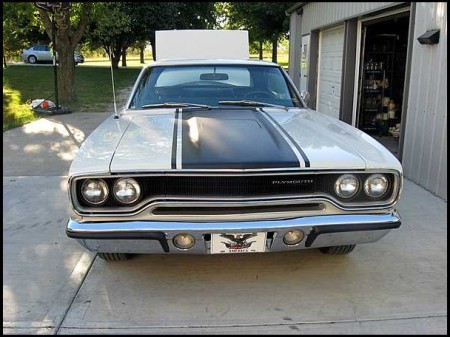 The white car is of course a 1970 Road Runner and while it came from the factory with a 383 and not a 440 that means the price for this one was $25,000 instead of the usual $40,000 these usually bring. Note the Air Grabber hood. The “door” in the hood is actually a vacuum operated scoop that pops up out of the hood to feed fresh air to the engine for increased horsepower. Nice and rare factory option.
The white car is of course a 1970 Road Runner and while it came from the factory with a 383 and not a 440 that means the price for this one was $25,000 instead of the usual $40,000 these usually bring. Note the Air Grabber hood. The “door” in the hood is actually a vacuum operated scoop that pops up out of the hood to feed fresh air to the engine for increased horsepower. Nice and rare factory option.
 The next cars are “continuation” models, meaning while they are built after the 1971 model year, they are what was previously Muscle Car Models. For those who like the Mopar vehicles of the Era these are the cheapest way to get a Mopar Muscle Car with the “look” from the era of the Muscle Car. The 1973 Plymouth Road Runner has the original 340 under the hood and sold for $12,500.
The next cars are “continuation” models, meaning while they are built after the 1971 model year, they are what was previously Muscle Car Models. For those who like the Mopar vehicles of the Era these are the cheapest way to get a Mopar Muscle Car with the “look” from the era of the Muscle Car. The 1973 Plymouth Road Runner has the original 340 under the hood and sold for $12,500.
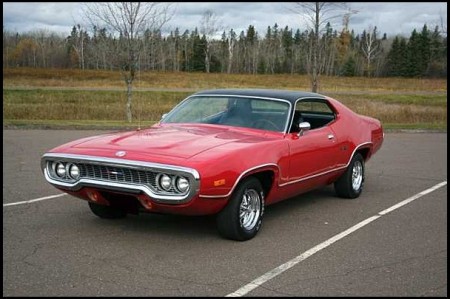 Next up is a 1972 Satellite Sebring Plus with the 340 cubic inch engine. Original throughout and only cost someone $8,500 to take it home. They also had a 1972 Sebring that sold for an even $10,000 at the Auction, also with the 340.
Next up is a 1972 Satellite Sebring Plus with the 340 cubic inch engine. Original throughout and only cost someone $8,500 to take it home. They also had a 1972 Sebring that sold for an even $10,000 at the Auction, also with the 340.
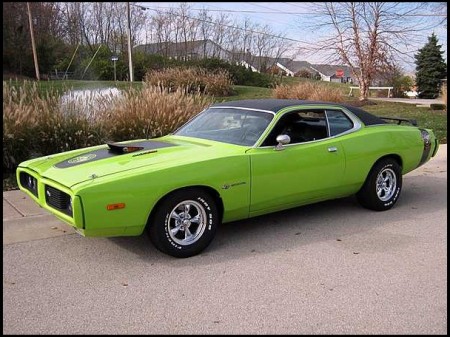 Then there was a 1973 Dodge Charger Super Bee replica with a 440 and the air grabber hood that sold for $16,000. Early years for the Super Bee were based on the Coronet body, but later models were based on the Charger body. So this would be an accurate “clone” even though the fender tags will tell people it is “just” a Charger.
Then there was a 1973 Dodge Charger Super Bee replica with a 440 and the air grabber hood that sold for $16,000. Early years for the Super Bee were based on the Coronet body, but later models were based on the Charger body. So this would be an accurate “clone” even though the fender tags will tell people it is “just” a Charger.
 Then to show you what earlier Super Bees looked like we come to our final picture for this post. This is a 1970 Dodge Super Bee. This car came with a 383 that is gone and now has been replaced with a bigger 440 engine. Because it is not a numbers matching car it sold for a low $16,500. Even with the non matching engine under the hood this car will “retail” for somewhere in the $40,000 range.
Then to show you what earlier Super Bees looked like we come to our final picture for this post. This is a 1970 Dodge Super Bee. This car came with a 383 that is gone and now has been replaced with a bigger 440 engine. Because it is not a numbers matching car it sold for a low $16,500. Even with the non matching engine under the hood this car will “retail” for somewhere in the $40,000 range.
While the prices of these cars may seem low and they are remember the price a collector or a dealer buys a vehicle for at an auction usually means he is the one who will benefit from the savings.
Well, that’s it for now. The next big Mecum Auction will be January in Kissimmee, Florida and then there are the half-dozen Arizona Auctions also even earlier in the month (January).
Guess, I should start looking through all their listings now to get ready. Take care everyone and remember that a Muscle Car is an Investment that you can actually enjoy having.
Davey Boy
Tags:1965, 1967, 1968, 1969, 1970, 1971, 1973, 1975, 440, 442, 454, AMC, Automobiles, cars, Chevrolet, Chicago, detailing, high return, investments, money, Muscle Cars, NHRA, Nova, Olds, Oldsmobile, Pontiac, profits, Racing, Trans Am, vehicle
Posted in Auctions, Automobiles, cars, current events, Muscle Cars, Racing, Uncategorized | Leave a Comment »
December 1, 2010
 For those who may be new to the idea of buying a classic Muscle Car, I am picking a few cars that should sell for around $20,000 and could possibly go a little higher. But based on the current economy and what recent auctions have done, I feel the at the $20,000 ceiling should be adequate. The blue car here is a 1968 Mustang with a 289. This vehicle makes for an excellent starter car due to the fact that with over 2 million Mustangs built during the Muscle Car era, parts are plentiful and inexpensive compared to most of these “dinosaurs”.
For those who may be new to the idea of buying a classic Muscle Car, I am picking a few cars that should sell for around $20,000 and could possibly go a little higher. But based on the current economy and what recent auctions have done, I feel the at the $20,000 ceiling should be adequate. The blue car here is a 1968 Mustang with a 289. This vehicle makes for an excellent starter car due to the fact that with over 2 million Mustangs built during the Muscle Car era, parts are plentiful and inexpensive compared to most of these “dinosaurs”.
Mustangs are small in size and fun cars to drive and even a little V-8 can really perk them up. The 289 is the engine that later became the 302, or as commonly known today the 5-0.
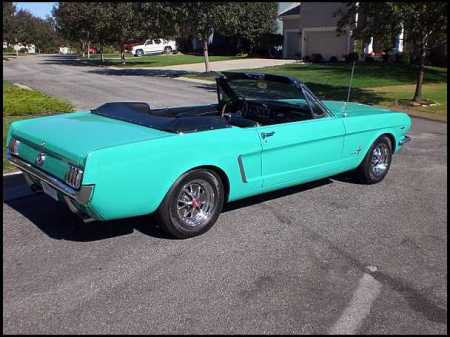 The light blue convertible would be a 1965 Mustang. Once again it has the 289 and this one is also a convertible so top down wind in the hair enjoyment comes with the price. Early Mustangs are plentiful, so even though a convertible can double or triple the price of the average collector car, that rule does not apply to Mustangs. Expect no more than $25,000 to become the owner of this little gem.
The light blue convertible would be a 1965 Mustang. Once again it has the 289 and this one is also a convertible so top down wind in the hair enjoyment comes with the price. Early Mustangs are plentiful, so even though a convertible can double or triple the price of the average collector car, that rule does not apply to Mustangs. Expect no more than $25,000 to become the owner of this little gem.
You never know if a collector is looking for a specific car in a particular color so should any of you actually try buying a vehicle I show here, remember my pricing should be used as a guide and if bidding goes crazy your best bet is to pass on the car, because the prices I quote are realistic. Most collectors will end up overpaying for a car that they deem special to their collection, and they usually do not buy cars to sell them right away so if they end up $10,000 over value, they know they will make that back eventually.
 The next car is a 1968 Pontiac LeMans with the 350 engine. Once again it is a convertible. Most people use the LeMans to build GTO clones and trying to find one in good condition that hasn’t been converted or relabeled as such can be difficult.
The next car is a 1968 Pontiac LeMans with the 350 engine. Once again it is a convertible. Most people use the LeMans to build GTO clones and trying to find one in good condition that hasn’t been converted or relabeled as such can be difficult.
As a rule the LeMans would go for around 15-18,000 dollars. In Hardtop form. A convertible can tip the $20,000 range. This one should end up around $26,000 as a maximum.
 Anyone who has read my blog postings would know that I have the utmost respect for the Chevrolet Nova due to its tremendous performance potential. This blue beauty is a 1968 with a 350. The owner has invested $30,000 in it to bring it back to what you see here. The shame is he won’t get that back. His overdoing it will become someone else’s prize. With the 350 it won’t pull wheelstands but then it is plenty of engine to pull this little car around town on cruise night in the summer. And the 350 from Chevrolet has probably more aftermarket parts than any engine ever made, so keeping it running will not be an issue. Expect a top price of $24,000, and really it could end up around $20,000 even.
Anyone who has read my blog postings would know that I have the utmost respect for the Chevrolet Nova due to its tremendous performance potential. This blue beauty is a 1968 with a 350. The owner has invested $30,000 in it to bring it back to what you see here. The shame is he won’t get that back. His overdoing it will become someone else’s prize. With the 350 it won’t pull wheelstands but then it is plenty of engine to pull this little car around town on cruise night in the summer. And the 350 from Chevrolet has probably more aftermarket parts than any engine ever made, so keeping it running will not be an issue. Expect a top price of $24,000, and really it could end up around $20,000 even.
 The white car is of course a 1970 Cutlass Supreme from Oldsmobile. These like the LeMans usually end up being cloned into real Muscle cars. In the case of a Cutlass that would mean labeling it as a 442. Unlike the GTO this entails more than just buying badges. The Supreme would not be a body that lends to cloning since it used the square top rear quarters, whereas the 442 used the rounded top “S” rear fenders, except for the convertible versions (they used the Supreme body).
The white car is of course a 1970 Cutlass Supreme from Oldsmobile. These like the LeMans usually end up being cloned into real Muscle cars. In the case of a Cutlass that would mean labeling it as a 442. Unlike the GTO this entails more than just buying badges. The Supreme would not be a body that lends to cloning since it used the square top rear quarters, whereas the 442 used the rounded top “S” rear fenders, except for the convertible versions (they used the Supreme body).
Still the Cutlass and the LeMans and the Buick Skylark as well as the Chevrolet Chevelle were arguably the best looking intermediates built during the era. All used 350’s from their division as a base V-8 and you could option a big block 400 and later years the 455 or 454 engines.
The 350 with a 4 barrel carb smoked the tires. The 400 roasted the tires. The 454 and 455’s just plain spun the tires untill the rear end was used up or the driveshaft broke free from under the car. While Chevrolet and Pontiac tried marketing towards the young crowd, the Oldsmobile and Buick vehicles mentioned here were more the “Gentleman’s” Hot Rod. And many people mistakenly thought that they were not as potent. This Cutlass should go for around $20,000 with a top run of about $26,000.
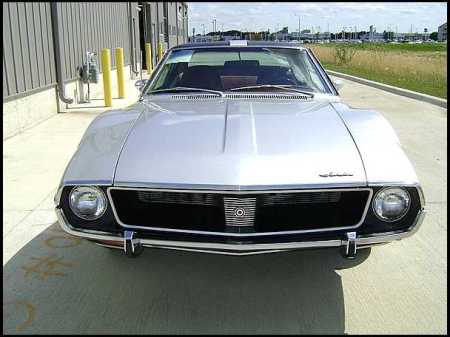 An American Motors Javelin with the 360 is next on the page. This is a 1971 model. One does not normally think of AMC as a muscle car company, but during the 1960’s and early 1970’s, all the American car company’s with the possible exception of Cadillac and Lincoln had a model or two at the minimum for performance minded consumers. The Javelin was the basis for the AMX which was basically a shortened Javelin with no back seat. AMC also had the Rebel “Machine” which eventually morphed into the Ambassador (not the Coupe). AMC did not sell the volume of cars that the Big 3 of Detroit did, so their engines and transmissions were a lot of times versions of Ford or Chrysler products. This makes parts compatibility possible but some of the engines do not share parts with their more popular brethren. Check for parts match if you want to build up an AMC. Because of this the AMC performance models do not have the higher price tags of their competitors. This beauty should sell for $24,000 at best.
An American Motors Javelin with the 360 is next on the page. This is a 1971 model. One does not normally think of AMC as a muscle car company, but during the 1960’s and early 1970’s, all the American car company’s with the possible exception of Cadillac and Lincoln had a model or two at the minimum for performance minded consumers. The Javelin was the basis for the AMX which was basically a shortened Javelin with no back seat. AMC also had the Rebel “Machine” which eventually morphed into the Ambassador (not the Coupe). AMC did not sell the volume of cars that the Big 3 of Detroit did, so their engines and transmissions were a lot of times versions of Ford or Chrysler products. This makes parts compatibility possible but some of the engines do not share parts with their more popular brethren. Check for parts match if you want to build up an AMC. Because of this the AMC performance models do not have the higher price tags of their competitors. This beauty should sell for $24,000 at best.
 Then we come to what could surprise even me. A 1972 Dodge Dart Demon with the 340 engine. Beautiful car with a bucket seat interior and the Mopars are among the hottest cars from the Muscle Car Era. They set records every year with the original Hemi engines monsters.
Then we come to what could surprise even me. A 1972 Dodge Dart Demon with the 340 engine. Beautiful car with a bucket seat interior and the Mopars are among the hottest cars from the Muscle Car Era. They set records every year with the original Hemi engines monsters.
This is not one of those and should sell for a reasonable $26,000 or less since it is a 1972. Technically the Muscle Car Era ended with the 1971 Models, but Mopar still was offering 440 engines and performance packages into the late 1970’s when their Corporate mandate was to use the 400 cubic inch “Lean Burn” engine as its top choice except for trucks and vans.
Well hopefully this will give someone a little help with getting into the Muscle Car Hobby. All these cars will be in Kansas City for the Mecum Auction and it starts TOMORROW.
Kind of short notice, but that’s how it goes sometimes. I apologize to everyone for not doing a report on here for a while, but hopefully I will have time to give more timely, regular blogs in the future.
Peace….
Davey Boy
Tags:1965, 1967, 1968, 1969, 1970, 1971, 1973, 1975, 440, 442, 454, AMC, AMX, Automobiles, cars, Chevrolet, Chicago, Cutlass, detailing, drag racing, high return, investments, making money, Muscle Cars, NHRA, Nova, Olds, Oldsmobile, Pontiac, profits, SS396, storage, Trans Am, vehicle, Wheelie
Posted in Auctions, Automobiles, cars, current events, Muscle Cars, Racing, Uncategorized | 2 Comments »
 Although not unprecedented, I am leading off with a photo that is not a car although, as I will explain is car related….kind of.
Although not unprecedented, I am leading off with a photo that is not a car although, as I will explain is car related….kind of. The photo credits belong to Matt Detrich/The Star and this is Mike Wanchic playing with John Mellencamp at the Hinkle Fieldhouse at Butler University on November 11, 2010. When I met Mike he had much shorter hair.
The photo credits belong to Matt Detrich/The Star and this is Mike Wanchic playing with John Mellencamp at the Hinkle Fieldhouse at Butler University on November 11, 2010. When I met Mike he had much shorter hair.

































